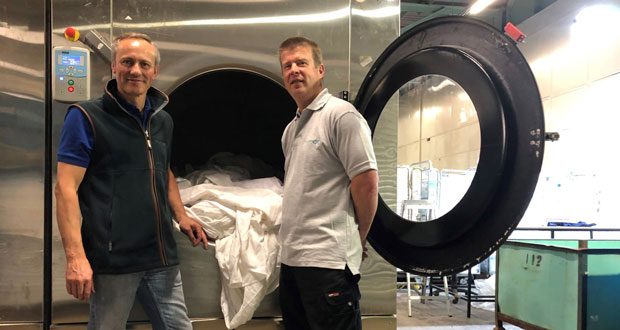Commercial linen cleaning services specialist, Regenex has set a new goal to process 1,000 tonnes of the UK’s dirtiest linen before its fourth birthday at the end of 2021.
The ambitious target, representing a step-up in operations, has been fixed despite ongoing disruptions to the laundry sector related to the pandemic.
So far, Regenex has successfully rescued 650 tonnes of discoloured white linen that would have been condemned to landfill or rag.
In addition, re-dyeing services have been applied to a further 75 tonnes of textiles. This includes:
- 15 tonnes of thermal hospital spreads, re-dyed with rich new colour
- 20 tonnes of new white scrub suits, dyed in line with a healthcare provider’s brand workwear colours
- 20 tonnes of continuous roller towels, dyed a vibrant blue
- 15 tonnes of faded, table linen, topped up to their original hue
- 5 tonnes of tired napkins and pillow cases, re-dyed for use as cleaning rags.
Current totals since Regenex began operations in 2017 mean 275 tonnes of material will need to be processed successfully at the company’s 25,000,sq ft premises in Bradford, West Yorkshire, by the end of 2021 to meet the goal.
Paul Hamilton, Technical Director, said: “On average we have rescued 242 tonnes of linen in each year since we founded, and in 2021 we are hoping to achieve 275 tonnes. This will mean by Christmas we will have saved 3,000 tonnes of carbon altogether.”
The 3,000 tonnes* of carbon eliminated is comparable to an entire year’s carbon footprint of 357 Brits. A total of 3.75bn litres of water** that would have been needed to manufacture new replacement linen will also be conserved.
Hamilton says: “These figures serve to highlight the environmental impact of our efforts so far, which were recently recognised in the International Green Apple Awards for good practice in protecting the planet.”
Regenex wants the laundry sector to use these disrupted times to rethink its attitude to textile waste – and develop more environmentally-friendly habits.
* Calculation based on 750 tonnes of linen typically halfway through its natural life cycle returned to stock, compared with carbon footprint of 8kg associated with the manufacture and life cycle of 1kg of new linen. Saving is 4kg carbon per 1kg cotton. According to http://www.globalcarbonatlas.org/ the average British person has a carbon footprint of 8.34 tonnes per year.
** Calculation based on the 10,000 litres of water required to manufacture 1kg of new cotton. The saving is 5,000 litres.





